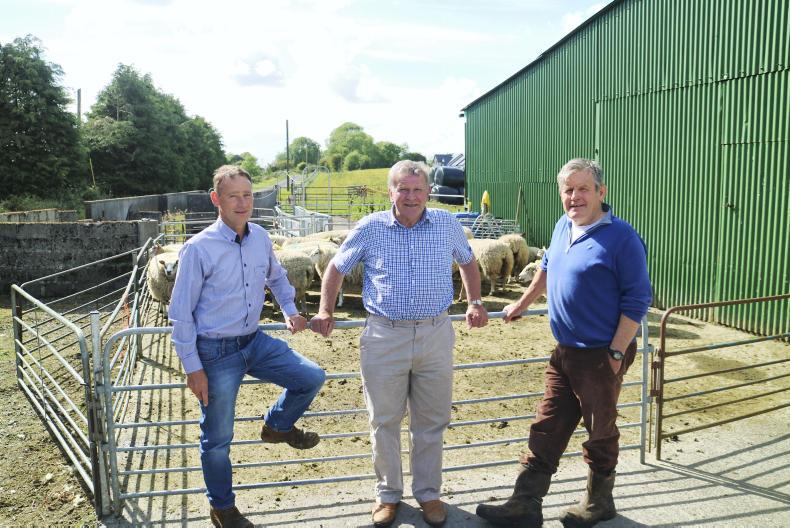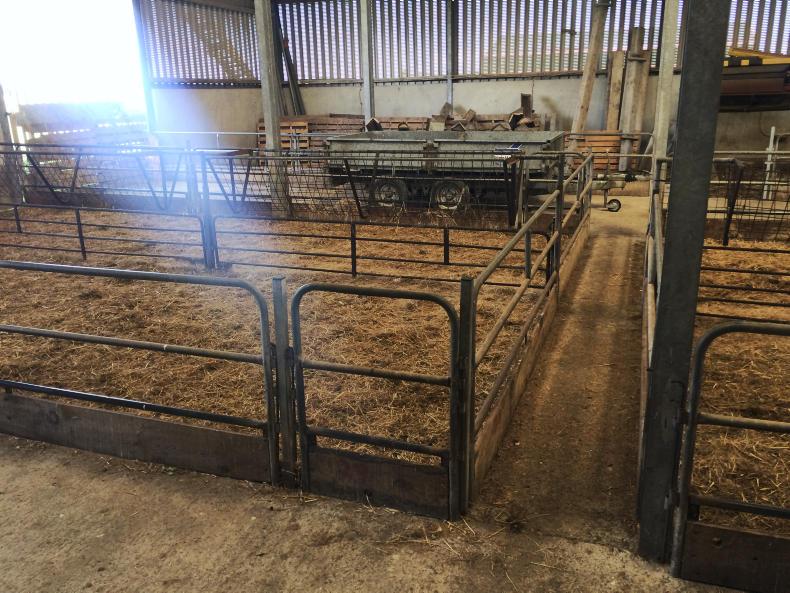Launched in early 2016, the QualEUtex Lamb Producer Group is well bedded in at this stage and looking forward to its second main production year. The group’s aim in 2017 is to increase its membership from the current 70 members and grow throughput of lambs with its processing partner Kepak Athleague.
Seamus Quinn farms a flock of 130 ewes and replacements in Brownesgrove, a short distance outside Tuam in Co Galway.
He joined the QualEUtex Lamb producer Group in 2016, as he found that a high percentage of his lambs were likely to meet the desired specification and be eligible for securing a premium payment of 30c/kg to 35c/kg.

Donal Mee,co-ordinator of QualEUtex Lamb Producer Group, founder member TJ Gormally and member Seamus Quinn
Sheep enterprise
Seamus’s farming system has undergone some changes in recent years. The traditional breeding programme was a crisscross programme using Texel and Suffolk sires, with replacements also retained from this mix. In recent years, Seamus has steered away from using Suffolk genetics, with more Texel breeding being used, while Beltex genetics have also been introduced for the last three to four years. As such, older ewes in the flock still retain some Suffolk genetics, while younger ewes are a mixture of Texel-cross mainly, with some possessing some Beltex breeding.
“There is nothing special about the flock, it is like any farm you could go on to,” says Seamus. “I don’t have any major preference on ewe type and I keep ewe lambs that I feel might work for me.
“Last year, I purchased some ewe lambs that were available from a known source with Rouge (de L’Ouest) and Beltex breeding. Some of these had lambs this spring and so far I am happy with what I’ve seen, so this may also be a route for the future.”
Grass-based system
The farm also differs slightly in its lambing date, with ewes lambed from 1 April onwards, with the majority lambing in a tight window of two to three weeks.
“The sheep enterprise was more intensive in the past, but in the last few years I have focused very much on trying to minimise labour and produce from a grass-based system. Ewes are stocked at about three ewes per acre and all lambs are finished off grass, bar a small number of triplets or lambs from problem ewes which receive some creep feeding.”
Sheep are grazed in a rotational grazing system and Seamus is a big believer in offering lambs fresh grass on a regular basis to maximise performance.
Topping is also utilised during the main grazing season, when required, to help maintain grass quality, while later in the season, lambs are allowed to graze the best-quality grass ahead of ewes.
Regular reseeding is carried out as required, with a focus on maintaining productive high-quality swards.
Another area that Seamus keeps high on the agenda is preventing health issues. He is a big believer as the season progresses in administering cobalt every 12 to 14 days, with this task tying in with regular drafting of lambs. Other tasks, such as worm dosing, fluke control and external parasite control, etc, are carried out routinely as required.
Slaughter performance
Looking at kill sheets of lambs slaughtered in 2016, over 90% of lambs achieved a carcase grade of E and U. The one area where Seamus admits he may need to tighten up on is in drafting lambs more regularly.
“The Beltex lambs work well in my system. They lamb pretty straightforward and are generally fairly easy to finish. However, you have to be careful, as they can kill much better than expected. I draft at around 40kg to 42kg early in the season, but for some lambs you may have to drop down to 38kg to prevent carcases going over the weight limit.
“Later in the season, the drafting weight could be 45kg to 47kg depending on the finish of lambs. Putting lambs on the scale more often and moving quicker is something that could be tightened up on.”
Good facilities
The flock’s scanning rate has averaged around 1.8 lambs per ewe in recent years. Mortality is very low and there are generally in excess of 1.6 lambs sold per ewe to the ram.
This is aided by close attention to detail around lambing and good facilities lending themselves to easier management around lambing.
The sheep shed is set-up very well, with walk-through feeders and hay racks in the centre of pens ensuring ewes have more than sufficient access to forage. Some hay is generally saved where required and this is also fed around lambing.
The hay shed adjoining the sheep shed is set up very impressively to make the best use of space and aid easier management.

There are two lofted areas which can be used to store hay/straw and lambing equipment, while in one corner underneath the lofted area there is a sectioned-off area with a sink and electrical supply that can be used to prepare bottles, etc. This also works great during lambing as an area to take a break if waiting on ewes to lamb.
It is also home to farm-related paperwork and can be used to store veterinary medicines, which Seamus says makes it much more convenient to record health treatments and keep paperwork in order.
The QualEUtex Lamb Producer Group
As mentioned previously, the QualEUtex Lamb Producer Group currently has about 70 members. Co-ordinator Donal Mee says interest levels are building, which ties in nicely with the aim of Kepak to increase throughput.
Lambs killing U2 or U3 and falling within the carcase weight range for the time of year receive a bonus payment of 30c/kg, with E2 and E3 grade lambs receiving a bonus of 35c/kg. The bonus is paid in addition to the Athleague base price for R3 lambs on the day of slaughter, with quotes listed each week on the group’s Facebook page.
Lambs are generally processed on two kill days in the week. The current carcase weight limit for the group running from 1 June to 31 July is 16kg to 21kg. From 1 August to 30 August, this increases to 21.5kg, while from 1 September to 30 November it increases another 0.5kg to 22kg.
From 1 December to Easter, an upper limit of 23kg applies, reducing to 20.5kg for new-season lamb from 1 April to 31 May. Lambs falling outside the spec will be paid in accordance with Kepak pricing applicable on the day of slaughter.
The cost of joining the group is a one-off charge of €50, with a charge of 30c/lamb deducted to contribute to cover group running costs. Lambs must be born on the farm of origin and sired by a purebred registered Beltex or Texel ram to qualify for the premium.
Donal says while the group does not supply haulage, they have a network of hauliers that they currently work with that may be in a position to provide haulage for interested parties.
This, he says, is working well in opening up avenues for farmers a significant distance from the plant who are interested in joining. Further information can be obtained from the group’s Facebook page or by calling Donal on 086-225 4932.
Kepak link
Kepak Athleague manager Michael Geoghegan says that the QualEUtex link-up is aimed at satisfying niche market demand from the Belgian market in particular for top-quality carcases.
He says that there is firm demand from this outlet and potential to continue to increase throughput, with the long-term aim of developing a stable year-round supply. He adds that delivering lambs within the desired carcase weight range and fat cover is particularly important to satisfy customer requirements.
Growing domestic consumption
One of the founding members of the QualEUtex group TJ Gormley says there is also huge potential to grow consumption of lamb in the Irish market.
“The QualEUtex initiative is a really good way of rewarding farmers who are producing carcases with higher conformation. Every extra sales avenue that farmers can access is vital in growing demand.
“I believe there is huge potential to grow consumption of lamb within the country, but to make this happen consumers need to have access to it.
“There is a local hotel in Tuam, the Ard Rí Hotel, that is selling nine to 11 legs of lamb every Sunday. There is a restaurant in Kerry that is growing demand for sheepmeat pies.
“The farmer or the factory cannot put lamb on the menu and we need Bord Bia and other relevant organisations to continue to exhaust all avenues to get lamb on the menu in more establishments. If this happens, I have no doubt that lamb consumption can recover and grow.”